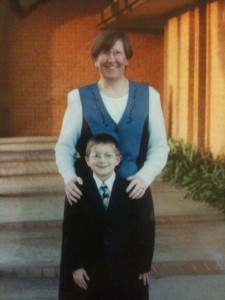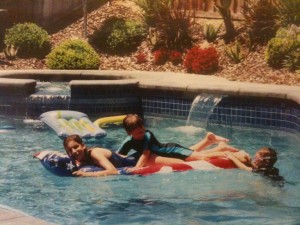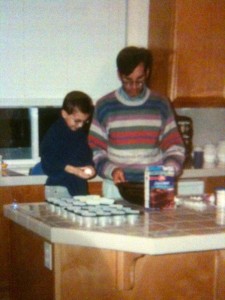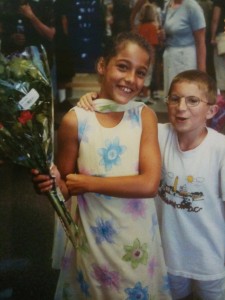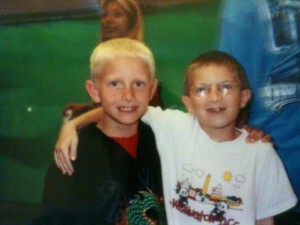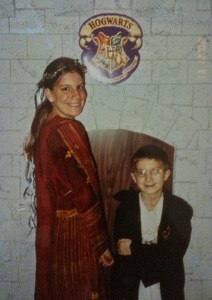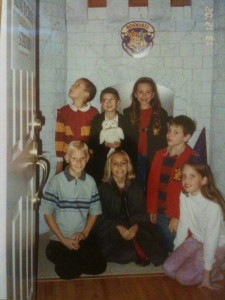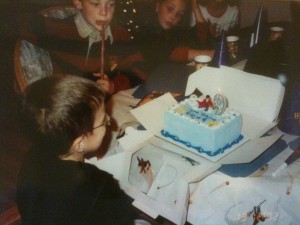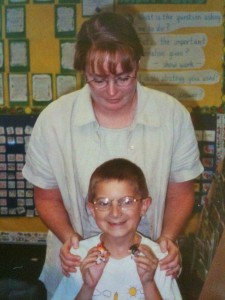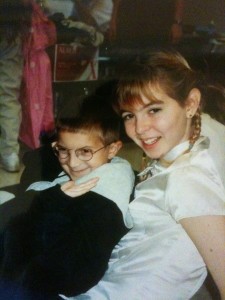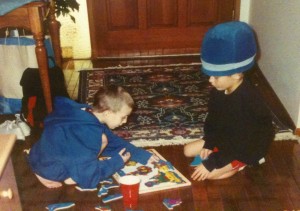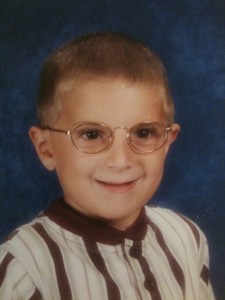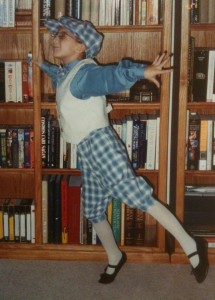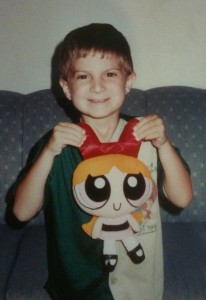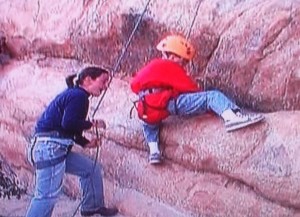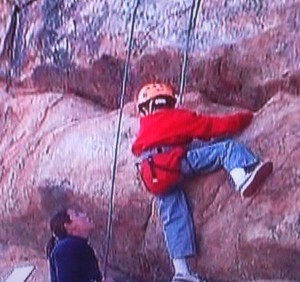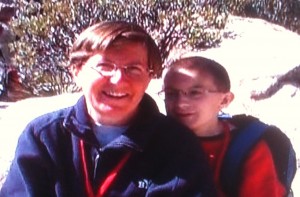Present word count of WIP: 53,497
One of the first books I read about Asperger’s syndrome after Jason was diagnosed was a brief, fascinating autobiography entitled Asperger Syndrome, the Universe, and Everything by Kenneth Hall, a British teenager. The book gave me hope because not only was its author an intelligent young man, fully capable of communicating how he felt about everything, but he seemed inordinately interested in spiritual matters.
I realize that may have been his particular obsession or interest, but one of the things I worried over most about Jason’s disability was whether, or how much, it would impact his involvement in our church.
LDS children are raised with certain expectations, or guided toward particular milestones, if you will, from an early age. Blessed at birth, usually by their fathers who hold priesthood authority, they are taught the gospel each Sunday in Primary from the age of three. When they reach the age of eight, they are given the choice to be baptized as members of The Church of Jesus Christ of Latter-day Saints. After baptism and confirmation as members of the church, again usually at the hands of their fathers and other priesthood holders, they continue learning simple lessons of the gospel on Sundays in Primary until they turn twelve.
At that point, the girls advance into the Young Women program. The boys, now part of the Young Men program, are ordained to be deacons in the Aaronic Priesthood, and they begin attending Priesthood Meetings. (At age twelve, both girls and boys begin attending youth Sunday School classes.) One of the duties of deacons is to help pass the Sacrament to the general congregation on Sundays. When each boy turns fourteen, he’s ordained to be a teacher, at which point he helps to prepare the Sacrament and he becomes involved with home visits. Then, at sixteen, he’s ordained to be a priest. This means he may now be worthy to bless the Sacrament and even perform the ordinance of baptism.
The next major milestone for an LDS young man is to serve a two-year mission for the church when he turns 19. (Young women may serve an 18-month mission, if they choose, once they are 21.) In preparation for the mission, the youth, once deemed worthy, enters the holy temple to make certain sacred covenants with the Lord and to receive necessary instruction.
The last milestone is a temple marriage, binding for eternity, not just this life.
Given all of this, you might well understand my concern about my son. Would he develop enough of a love for God to want to pursue all these goals? Would he gain a testimony? How much would he be able to love and serve others?
It can be difficult for those with an autistic spectrum disorder to empathize because they are so caught up in their own world. There’s a whole theory of mind problem, about which scientists have done experiments, proving that it’s nigh impossible for these children to put themselves in another’s shoes.
This is why that autobiography gave me so much hope.
So we continued to take Jason to church every Sunday and I helped him prepare and give talks in Primary. We went to all the ward activities, but usually couldn’t stay the whole time because the noise and numbers of people would get to him after a while…or if it was held outside, our stay was even shorter. Michael or I would take Jason home while the other remained with Allison.
By the time he turned eight, most of the adults in our ward knew he had been diagnosed with AS or at least that he was a bit “different.” I was nervous about his baptism. He enjoyed swimming in our pool, but I kept thinking we ought to borrow one of the white baptismal outfits and let him try it out in our pool to get used to the feel of having wet clothing on. We never did, though.
We got to the day of his baptism. In our stake in Riverside, CA, they would have one service for all the children being baptized on a Saturday. Because there were four scheduled to enter the waters of baptism that day, and so many had come to share in the experience, we had the service in the Stake Center chapel. Jason, who had a beautiful boy soprano voice, had volunteered to sing a solo, “When Jesus Christ Was Baptized,” and he did it perfectly. Then we went back to where the font was.
Seeing the font full of water, he began to get nervous and elected to go last. The longer he had to wait, the more nervous he got. When it was his turn, it was all Michael could do to convince him to step out of the Men’s changing room and step into the water. It must have taken a good ten or fifteen minutes (though it seemed longer) of hearing his high-pitched voice saying, “No, no…I don’t want to!” as Michael gently tried to convince him it would be all right.
At about the moment the Stake President, who was there, was ready to call it off and give us permission to baptize him later in our backyard pool, Jason and Michael finally came out and took the first step down into the warm water. It took another five minutes to get him to take the next step. As the water begin to soak through the bottoms of his pant legs, he said, “It feels funny. I don’t like it.” He almost turned around again, but somehow Michael got him to step all the way down, then quickly baptized him. I can tell you, practically everyone in the congregation felt like cheering at that point (particularly the Stake President).
One milestone down.
We had a few more years to breathe before the next one. (I’m not even mentioning the Boy Scout program, which turned out to be a total wash, as far as Jason was concerned. He stuck it out with Cub Scouts and Frank Gonzalez was a terrifically patient Webelos Leader. But he couldn’t stand the camp outs once he became a Boy Scout.)
The real challenge at church was his peers, but I can’t really blame them, looking back now. I should have done the same thing with them that I ended up doing with his classmates at school in fifth grade.
When his fifth grade class began studying the brain, I saw a golden opportunity to nip a growing problem in the bud. Up until then, his classmates had been pretty supportive, but in fifth grade the teasing was beginning again. One day when Jason had had a particularly hard time of it, he asked me why he felt so different from everyone else.
This was the day I’d been waiting for. All the experts had advised not telling your child about his diagnosis until he seemed ready for it. I knew he was ready. So, Michael and I sat down with him and, using a simple book I’d found that was written on a child’s level, we told him about Asperger’s syndrome. I’m not sure how he took it at first, but once I arranged to give a special presentation about it to his fifth grade class, he began to feel almost empowered in a way. Another class sat in on it, as well, and they were all enthralled. Suddenly, they understood why Jason behaved the ways he did and they no longer made fun of him. Instead, they stuck up for him.
If only I had insisted on giving that same presentation to his peers (and their parents) in our ward. It would have saved a lot of heartache, I think.
In any case, when Jason turned twelve he was ordained a deacon. He seemed to be the littlest deacon up there passing the Sacrament, but they were kind and gave him an easy route to remember.
Some eight months later, we moved to Washington and, as I said before, into a ward that already knew their way around Asperger’s.
Are there still challenges? Sure. He still hates Boy Scouts and camping. He’s grown shy in front of an audience, so he has yet to give a talk or bear his testimony (though he came close) in Sacrament Meeting. He’ll sing in the choir, but refuses to sing a solo even though he now has a beautiful bass voice. He goes to the temple with the youth to do temple baptisms, but only does the confirmations.
But as a priest now, he blesses the Sacrament with sincere power and authority. And he accompanies his father on home teaching visits, even giving the lesson now and then.
And in January, after he’s turned 19, he plans on serving a two-year local service mission.
Who knows? Perhaps a temple marriage yet lies in his future.
Only Jason can answer the most important questions about how he really feels about God and Jesus Christ and his relationship to them. All I know is that he’s come a long way spiritually from that little boy of eight who didn’t want to come out of the changing room and step into the water.
Originally posted 2012-04-29 20:42:24.

